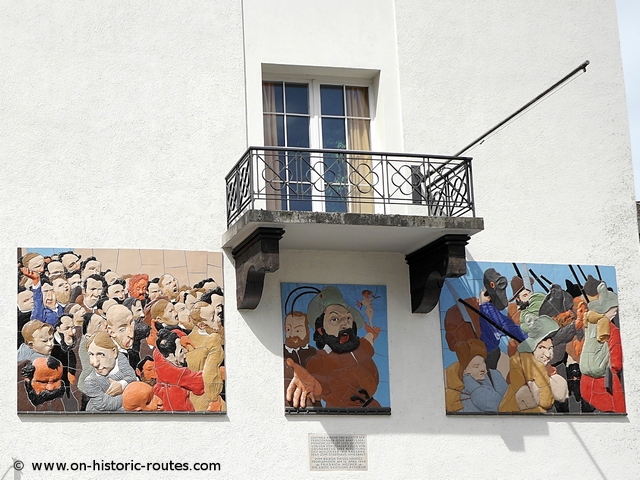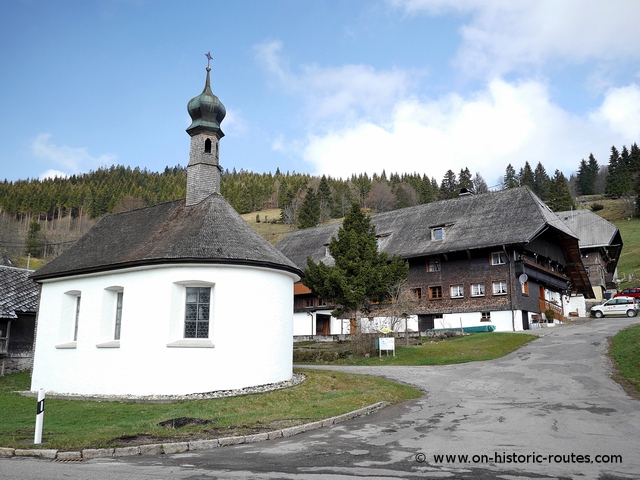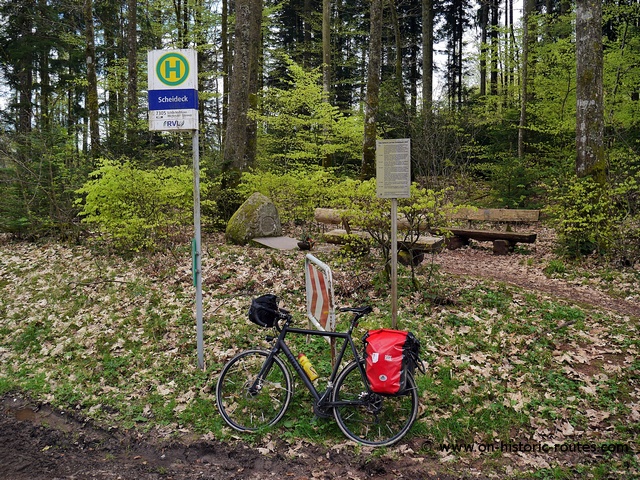1848 was a year of unrest in Germany. Inspired by the new French Second Republic, created in February, Germans also wanted more democracy.
On 13.April 1848 Friedrich Hecker led a column of about 30 men from Constance in an open attempt to topple the government of the Duchy of Baden and declare a republic. Seven days later, his group had grown to 1,000 men but it was defeated in a battle with government troops.
The story of the failed Hecker Uprising is little known in Germany and I was interested if I could find traces of it on the route. It took Hecker seven days to lead his column more than 200 km from Lake Constance through the Black Forest to the battle site in the Rhine Valley. A route that I planned to cover in three days by bike in April 2015, 167 years later.

1848 – The Spring of Nations in Baden
Friedrich Hecker was a lawyer and politician in the German princely state of Baden. The Grand Duchy close to France was among the more liberal places in Germany at the time.
He was also a member of the all-German parliament that was in session in 1848 in a response to the unrest. His experience in the parliament showed Hecker that a democratic government would not be established in Baden or in overall Germany. This is when he decided to start an armed rebellion to establish a republic.
He deemed the region close the Swiss border most ready for an uprising and his plan was to gather troops along the way from Constance to the capital in Karlsruhe sufficient to force his claims.
Before setting off from Constance, he made his plan public and asked for the local population to join him on his march to topple the government.
Therefore, Government troops were aware of his actions and blocked his way in Donaueschingen and near Freiburg, forcing Hecker into the South-West corner of Germany, where his troops were utterly defeated.
Like many other Germans, disappointed by the failed 1848 revolution, Hecker emigrated to the USA, where he owned a farm in Illinois. As a leading Forty-Eighter, he was also active in the Republican Party and fought as an officer in the Civil War.
Hecker Uprising Route Today
The route of the Hecker uprising is easy to follow by bike today and I was curious what to find along the way, when I arrived in Constance by train.
Typically for mid-April the weather was nice and warm. After all it was Spring and throughout the trip the light green of fresh leaves dominated nature.
This was probably not different in 1848. I wondered how the season played a role in Hecker’s success of motivating people to join him in his rebellion. I could not find any information about it but I would not be surprised if the rush of energy that comes with Spring helped him attract people for his cause.
Even is he failed overall, he was able to raise about 1,000 men along his way. His friend Franz Sigel, another famous Forty-Eighter, led a column of about 4,000 men following Hecker by two days. A lot of people were willing to follow an armed uprising. Most of these men were educated, being journeyman or master in their profession.
There are few traces of Hecker in Constance. Most prominent is a colorful mural showing Hecker and his troops.
Constance is a hectic mid-size town and I was happy to leave. The small rural villages and towns along the way with their medieval buildings gave more of an impression of how Hecker might have seen this area in the south of Germany.
Traces however, were rare. A series of plagues, sponsored by the state government, showed stops along his way. These were mostly inns where Hecker gave speeches to raise men for his cause.
A prominent example along the route is the “Adler” (”Eagle”) in Bernau. Established in 1698, is is still used as an inn today. Hecker met here with emissaries from the national parliament. They offered an amnesty but Hecker refused to compromise.
These old inns are a neglected part of heritage. They are around for centuries like the “Adler”, were an important part of their communities before TV and internet and were part of the infrastructure as they often were integrated in the coach services as coach stops.

Traveling 167 years ago
Infrastructure certainly was different 170 years ago. There were no cars, Autobahn or even bicycles. There were paved roads however between towns and Hecker’s route mostly follows them. His group was able to cover 35 km on average per day. This included stops along the way with speeches and encouraging discussions to sign up more people. Such a mileage would have been difficult to sustain without proper roads.
Crossing the Black Forest mountain passes from Lenzkirch into the Wiese Valley was more likely done on trails due to the mountainous terrain at more than 1,000 m.

Today the picturesque landscape and villages of the Black Forest attract tourists but in the 19th century the area was very remote. This is among the reasons Hecker used it to evade the Federal troops that tried to block him along the main routes through the Black Forest from either Donaueschingen to Offenburg or Neustadt to Freiburg.
Railways are an interesting aspect of this story. Obviously they would lead to a transport revolution later in the 19th century, but were not widespread in 1848. The Grand Duchy of Baden however was in the process of building a line along the Rhine Valley and it was in operation from Mannheim in the north to Schliengen south of Freiburg.
Federal troops could be moved on trains all along the Black Forest giving Hecker not the slightest chance to out-maneuver them.
The way to the battle at the Scheideck Pass
After crossing the Black Forest by bike I was looking forward to cruising down the Wiese Valley. Following a bike path along the route of a disused railway made this particularly easy.
The Wiese Valley was a hotspot of the revolutions of 1848 and it is where the different columns of Hecker, Sigel and others missed their chance to coordinate their efforts.
Much of the motivation behind the unrest was due to changes in society that were not reflected in the non-participatory governments of the time. The Industrial Revolution was a big part of these changes and the Wiese Valley was an area where it already had taken hold in 1848.
The river was used to power machines here and the textile industry was an important economic factor for Baden.
Interestingly enough, during his last night on the route in Schopfheim, Hecker – the revolutionist – dined with a local industrialist to discuss politics.
The last stretch of the route to the site of Hecker’s final defeat – the Scheideck Pass – was again a typical Spring scene. Colorful flowers, apple and cherry trees blossoming and the forest covered in light green leaves.
This atmosphere full of energy does not fit the sudden and crushing end to the spring uprising back in 1848.

Outnumbered and facing professional troops, the rebels gave a short fight before they had to retreat. The commanding officer of the federal troops was killed in the engagement along with 13 other soldiers and rebels. A small monument at the Scheideck Pass is the only trace of this battle.
Hecker fled to Switzerland and most of his disappointed followers back to their hometowns.
Today the events around the German Revolutions of 1848/49 are often seen as the birthplace of democracy in Germany. Especially the Frankfurt Parliament of which Hecker was a member and its constitution were the foundations for the Weimar Republic and the modern German Republic.
The events of the Hecker Uprising however receive very little attention and finding traces of it proved difficult along the 250 km route.
Theme routes are quite popular in Germany. Along my three day trip alone, several signposted railway heritage trails, a trail inspired by a local poet and the Danube bike trail were well signposted and had additional information panels. The contrast to the Hecker Uprising route was striking.
For me it was an interesting journey however looking at the landscape through the lens of the Hecker Uprising.

Then sign up for our free email newsletter to get all our new posts right to your inbox.
